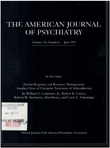Daytime alertness in patients with primary insomnia
Abstract
OBJECTIVE: In the absence of clear distinctions in alertness between patients with primary insomnia and normal subjects, the goal of this study was to identify psychometric and electrophysiological measures that would distinguish these two groups. METHOD: The daytime alertness of 20 primary insomnia patients and 20 normal subjects was investigated through their scores on a 26-item hyperarousal scale and measurement of auditory evoked potentials and alpha and nonalpha band EEG activity. Statistical analysis of the data included correlation of the hyperarousal scores and the electrophysiological measures. RESULTS: The hyperarousal scores showed clearly higher daytime alertness in the insomnia patients compared with the normal subjects. In addition, during wakefulness, the insomnia patients showed greater amplitudes of P1N1, a durable, intrinsic, late (cortical) component of the auditory evoked potential, as well as greater EEG activity across the frequency spectrum. The hyperarousal scores correlated positively with the amplitude of P1N1 at each of three sound intensities. CONCLUSIONS: To the authors' knowledge, this is the first study to offer evidence that patients with primary insomnia have objectively definable features during wakefulness that clearly distinguish them from normal subjects. The measurement of hyperarousal might be used to refine descriptions of insomnia populations in experimental studies.
Access content
To read the fulltext, please use one of the options below to sign in or purchase access.- Personal login
- Institutional Login
- Sign in via OpenAthens
- Register for access
-
Please login/register if you wish to pair your device and check access availability.
Not a subscriber?
PsychiatryOnline subscription options offer access to the DSM-5 library, books, journals, CME, and patient resources. This all-in-one virtual library provides psychiatrists and mental health professionals with key resources for diagnosis, treatment, research, and professional development.
Need more help? PsychiatryOnline Customer Service may be reached by emailing [email protected] or by calling 800-368-5777 (in the U.S.) or 703-907-7322 (outside the U.S.).



